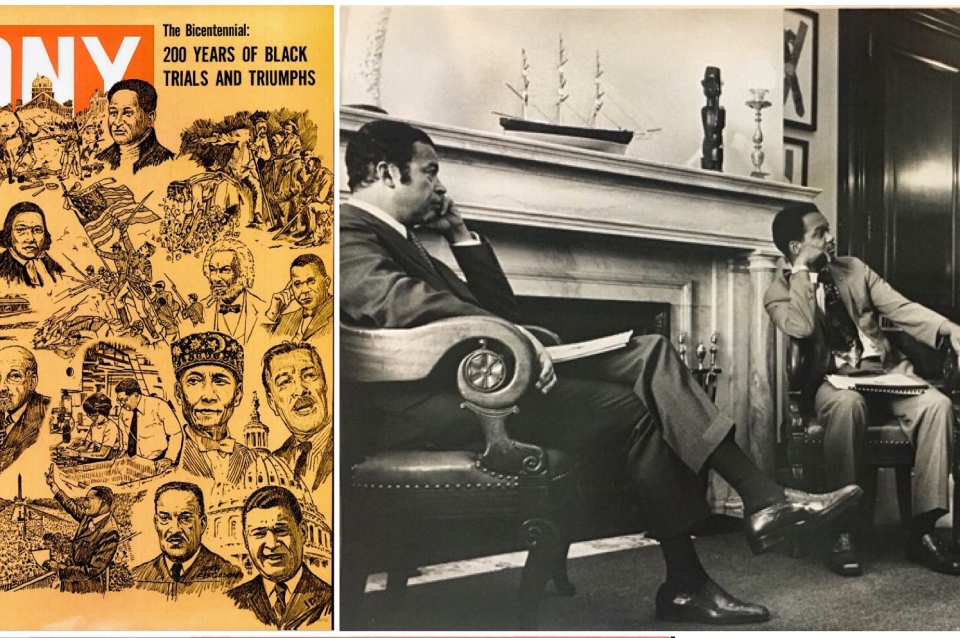
Left: Cover of Ebony magazine special issue on the Bicentennial, August 1975; Right: Senator Edward Brooke (R-Mass) and Congressman Walter Fauntroy (D-DC), being briefed by Vincent deForest, co-founder of the Afro-American Bicentennial Corporation, early- to mid-1970s.
Close
Left: Cover of Ebony magazine special issue on the Bicentennial, August 1975; Right: Senator Edward Brooke (R-Mass) and Congressman Walter Fauntroy (D-DC), being briefed by Vincent deForest, co-founder of the Afro-American Bicentennial Corporation, early- to mid-1970s.
Clockwise from top: Carter G. Woodson at his second-floor office desk in 1948. Scurlock Studio Records, ca. 1905-1994, Archives Center, National Museum of American History; Streetscape of Woodson home looking southwest, February 2019. Amber N. Wiley; General view of block. Carter G. Woodson House, 1538 Ninth Street NW, Washington, D.C., 1979. Woodson House second from right. U.S. Department of the Interior, National Park Service, Historic American Buildings Survey. Carter G. Woodson House HABS No. DC-369.
Top: T. M. Haynes Building, 1909, in foreground. This building was listed as a contributing structure to the Boley Oklahoma National Historic District in the Afro-American Bicentennial Corporation nomination to the National Park Service. West side Pecan Street, Boley, Oklahoma. Roger Meyers, photographer. Afro-American Bicentennial Corporation, National Register of Historic Places Inventory – Nomination Form, “Boley Oklahoma Historic District.” 1974; Bottom: T. M. Haynes Building, west side Pecan Street, Boley, Oklahoma, Google Street View. 2016.
Amber N. Wiley | The Revolution Continues: The Legacy of Black Heritage Movement
Historic Preservation Lecture
Thursday, March 4, 2021
5:30 pm
Zoom

 View Slideshow
View Slideshow

 Amber Wiley is an Assistant Professor of Art History at Rutgers University. Her research interests center on the social aspects of design and how it affects urban communities - architecture as a literal and figural structure of power. She focuses on the ways local and national bodies have made the claim for the dominating narrative and collective memory of cities and examines how preservation and public history contribute to the creation and maintenance of the identity and sense of place of a city. Her publications cover African American cultural heritage, urbanism in New Orleans, school design, urban renewal, and preservation. Her current book project is entitled Concrete Solutions: Architecture, Activism and Black Power in the Nation’s Capital.
Amber Wiley is an Assistant Professor of Art History at Rutgers University. Her research interests center on the social aspects of design and how it affects urban communities - architecture as a literal and figural structure of power. She focuses on the ways local and national bodies have made the claim for the dominating narrative and collective memory of cities and examines how preservation and public history contribute to the creation and maintenance of the identity and sense of place of a city. Her publications cover African American cultural heritage, urbanism in New Orleans, school design, urban renewal, and preservation. Her current book project is entitled Concrete Solutions: Architecture, Activism and Black Power in the Nation’s Capital.